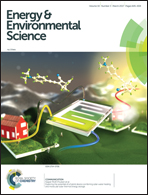The synergistic effect of H2O and DMF towards stable and 20% efficiency inverted perovskite solar cells†
Abstract
A high quality thick (500 nm) CH3NH3PbI3 perovskite absorber with a horizontal grain size up to 3 μm and a lateral size equal to the film thickness was prepared by the synergistic effect of a H2O additive and DMF vapor treatment via a two-step spin coating method. The inverted (p–i–n) cell based on this high-quality thick perovskite film achieves a high power conversion efficiency of 20.1%. The cell shows no current hysteresis and is stable in inert and ambient atmospheres with appropriate encapsulation. H2O helps MAI to penetrate into the thick PbI2 to form a thick film with a pure MAPbI3 phase and produces bigger gains by slowing down the perovskite crystallization rate. It can also cooperate with DMF to control the dissolution of perovskite grains during DMF vapor post treatment. As a result, large multi-crystalline perovskite grains without observable holes and creases are formed when DMF and H2O were removed during the following heating process. The synergistic effect of H2O and DMF was evidenced by SEM images and GIWXRD patterns taken simultaneously. This synergistic strategy for preparing a high-quality, thick perovskite film was extended to fabricate a large-area MAPbI3 film (1.3 cm2 and 11.25 cm2 for the cell and mini-module, respectively) to realize an efficiency of 16.7 and 15.4%.



 Please wait while we load your content...
Please wait while we load your content...